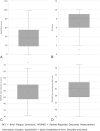Patient-Reported Symptom Burden of Charcot-Marie-Tooth Disease Type 1A: Findings From an Observational Digital Lifestyle Study
- PMID: 36005469
- PMCID: PMC9394494
- DOI: 10.1097/CND.0000000000000426
Patient-Reported Symptom Burden of Charcot-Marie-Tooth Disease Type 1A: Findings From an Observational Digital Lifestyle Study
Abstract
Objectives: This study aims to explore the impact of Charcot-Marie-Tooth disease type 1A (CMT1A) and its treatment on patients in European (France, Germany, Italy, Spain, and the United Kingdom) and US real-world practice.
Methods: Adults with CMT1A (n = 937) were recruited to an ongoing observational study exploring the impact of CMT. Data were collected via CMT&Me, an app through which participants completed patient-reported outcome measures.
Results: Symptoms ranked with highest importance were weakness in the extremities, difficulty in walking, and fatigue. Almost half of participants experienced a worsening of symptom severity since diagnosis. Anxiety and depression were each reported by over one-third of participants. Use of rehabilitative interventions, medications, and orthotics/walking aids was high.
Conclusions: Patient-reported burden of CMT1A is high, influenced by difficulties in using limbs, fatigue, pain, and impaired quality of life. Burden severity appears to differ across the population, possibly driven by differences in rehabilitative and prescription-based interventions, and country-specific health care variability.
Copyright © 2022 The Author(s). Published by Wolters Kluwer Health, Inc.
Conflict of interest statement
The authors report no conflicts of interest.
Figures





References
-
- Kedlaya D. Charcot-Marie-Tooth disease; 2021. Available at: https://emedicine.medscape.com/article/1232386-overview. Accessed November 22, 2021.
-
- Pareyson D, Saveri P, Pisciotta C. New developments in Charcot–Marie–Tooth neuropathy and related diseases. Curr Opin Neurol. 2017;30:471–480. - PubMed
-
- Reilly MM, Shy ME. Diagnosis and new treatments in genetic neuropathies. J Neurol Neurosurg Psychiatry. 2009;80:1304–1314. - PubMed
-
- Hereditary Neuropathy Foundation. What It's Like to Live with Charcot-Marie-Tooth (CMT): The Stories of those Who Know Best; 2015. Available at: https://www.hnf-cure.org/essential-guide/. Accessed November 25, 2021.
-
- Pareyson D, Marchesi C. Diagnosis, natural history, and management of Charcot-Marie-Tooth disease. Lancet Neurol. 2009;8:654–667. - PubMed

